 Voice Service
Voice Service The results of the main KPIs for voice tests achieved by operators with the split per the aggregation type are presented in Figure 1.
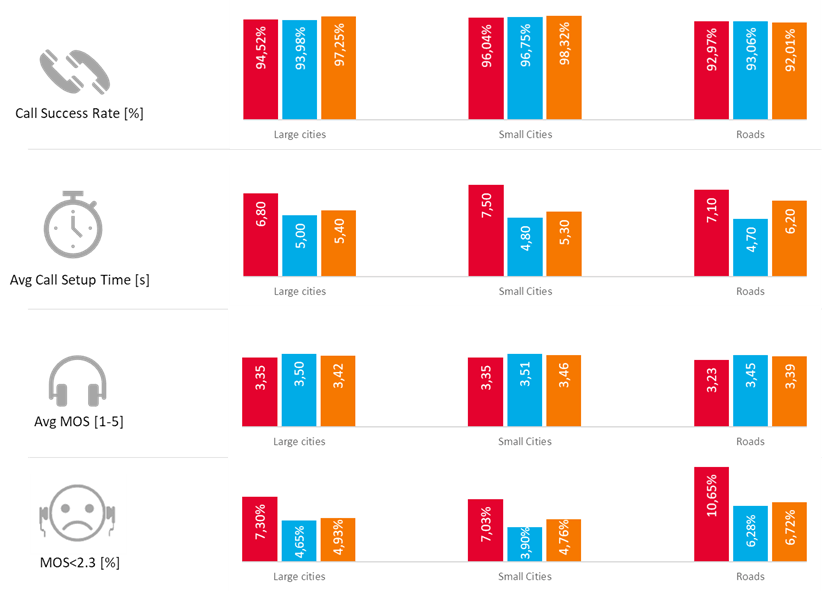
Fig. 1. Results of main KPIs for voice tests
Large Cities:
Vip mobile showed the best call success rate, whereas the call success rate in Telekom Srbija and Telenor networks were behind and close to each other. The longest average call setup time was 6.8 seconds in the Telekom Srbija network, while the shortest average time to establish the call was 5.0 seconds in the Telenor network. Telenor had the best speech quality (MOS) and the lowest percentage of bad speech samples. Telekom Srbija had the highest percentage of bad speech samples – 7.3% of samples had MOS lower than 2.3, which is perceived as bad speech quality.
Small Cities:
The call success rate for Vip mobile is the best amongst all aggregations. Call success rates in Telekom Srbija and Telenor were similar, but not reaching the minimum expected value of 97%. The longest average call setup time was 7.5 seconds in the Telekom Srbija network, whilst the shortest was measured in the Telenor network, namely 4.8 seconds. The best speech quality was measured in the Telenor network at a MOS level of 3.51. Telenor had the least amount of bad quality speech samples (3.9%), while Telekom Srbija had the most (7.0%).
Roads:
Call success rates in the Telekom Srbija and Telenor networks were similar, Vip mobile was worse by 1 percent. No network reached the minimum expected call success rate value. The longest average call setup time was 7.1 seconds for Telekom Srbija, whilst the shortest (4.7s) was measured in the Telenor network. The best quality of speech was found in the Telenor network at a MOS level of 3.45. Vip mobile achieved a MOS at level of 3.39 and Telekom Srbija 3.23. The percentage of samples with a MOS worse than 2.3 in Telekom Srbija network exceeded 10%, while other competitors scored better in this metric.
In Table 1, voice failed calls and dropped calls scores for all three operators in different aggregations are shown.

All three mobile operators had problems with reaching the minimum expected call success rate which is dependent on call setup failures and the dropped calls rate. In Large Cities only Vip mobile met that threshold, having the best call success rate. In general, well performing mobile networks are having less than 1% of failed calls. Most of the failed calls in Telenor network were caused by paging issues, and in Telekom Srbija network by 3G network quality and mobility issues.

The lowest percentage of dropped calls was in the Vip mobile network and was equal to 0.29%, which is more than 1 percent better than competition. Almost all drops in all three networks were detected in Belgrade, only Telenor had several dropped calls located in the southern cites. Most of the dropped calls in Telekom Srbija and Telenor networks were caused by poor 3G network coverage and quality.
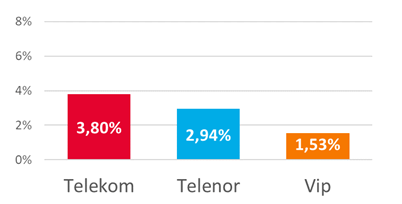
In Small Cities, only Vip mobile met the minimum expected call success rate, as it had less than 3% of both failed and dropped calls. Most of the failed calls in the Telenor network were caused by paging issues, and in Telekom Srbija network by mobility issues.

The percentage of dropped calls in Small Cities was very low for all three mobile operators. The worst result was achieved in the Telenor network and was equal to 0.31%, which still should be considered as a very good result.

As expected, the results on Roads were worse than within the cities. There was no specific region with a concentrated number of failed calls, as those events were distributed throughout the country. Finally, even though the minimum expected call success rate for Roads is set to lower value, no network was able to meet this criterion. The vast majority of failed calls in the Vip mobile and Telenor networks was associated with the poor coverage, whereas in Telekom Srbija network most of the calls failed to establish due to the mobility issue.
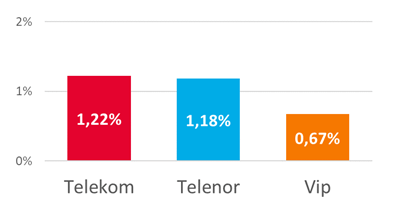
The dropped calls rate of Telekom Srbija and Telenor were close to each other. The lowest percentage of dropped calls was measured for the Vip mobile network and was equal to 0.67% which is 0.5 percent better than the competition. Most of the dropped calls in the Telekom Srbija and Telenor networks were caused by poor radio coverage.
Table 1. Voice Failed Calls and Dropped Calls
Figure 2 below presents average call setup time values for all three operators in different aggregations.
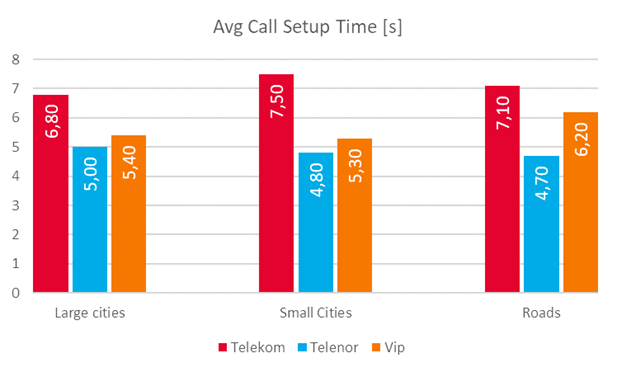
Fig. 2. Average call setup time values
In the Telenor network, call setup time was significantly shorter, compared to the other two mobile networks. It took less than 5 seconds to establish a call in every aggregation. Telekom Srbija scored the worst, since it was the only mobile operator without fast the alerting functionality being implemented. The call proceeding to paging response time was also longer in the Telekom Srbija network than for the competition.
VoLTE (Voice over 4G) technology is currently not supported in the Serbian market, and therefore when the mobile device is connected to the 4G network and used to make or receive voice call, the device falls back to the 3G or 2G network to complete the call. This procedure is known as the CSFB (Circuit Switched Fall Back) and is part of the call setup procedure. All 3 mobile operators mostly fall-back calls to 3G.
Telenor had the shortest CSFB duration with an average around 0.6 seconds. It was followed by Vip mobile, while Telekom Srbija was further behind with an average longer than 1.4 seconds. Longer CSFB duration in Telekom Srbija network is one of the contributors to the longer call setup time.
Distribution of CSFB duration in Large Cities for all three mobile operators is presented in Figure 3:
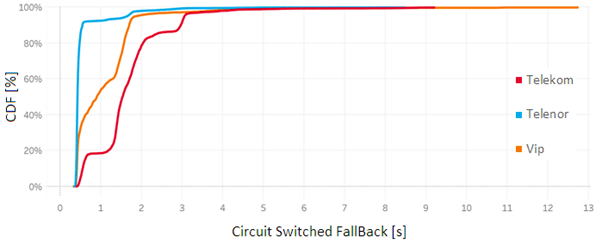
Fig. 3. CSFB duration in large cities
Figure 4 below presents average MOS values for all three operators in different aggregations.
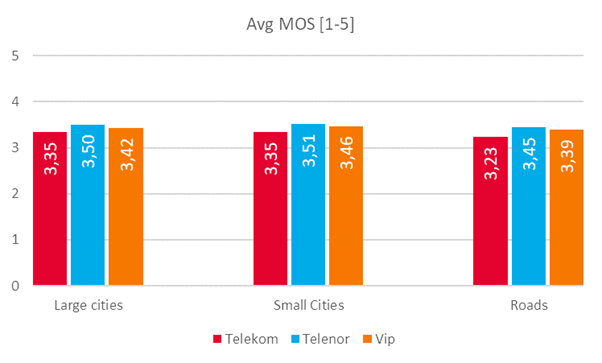
Fig. 4. Average MOS values
There is a variety of speech coding methods allowing transmission of the speech effectively. The use of codecs is determined by the quality of radio signal, available network technology and capacity of the network. Codecs offering the best speech quality require good radio conditions, reasonable radio resources and support of the codec by the network and mobile devices at both ends of the connection. In cases where the capacity of the network is limited, mobile operators use codecs with more efficient compression of the speech, but also providing worse speech quality. The distribution of the codecs used has a direct influence on the voice quality represented by MOS value (from 1 to 5, the best being 5). The AMR WB (Adaptive Multi-Rate Wideband) codec offers the best speech quality.
Telenor achieved the best speech quality in all aggregations, followed by Vip mobile and Telekom Srbija. The results correspond to use of network technologies and voice codecs. Telenor used AMR WB codec for more than 90% of speech samples in Large and Small Cities, and for 88% of speech samples on the Roads. The usage of AMR WB codec in the Vip mobile and Telekom Srbija networks is slightly lower, resulting in lower speech quality achieved.